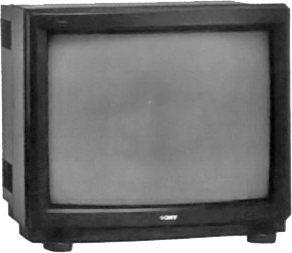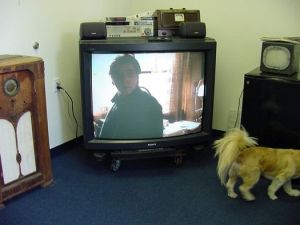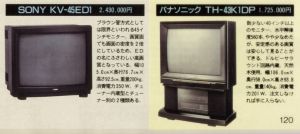CRT:PVM-4300: Difference between revisions
mNo edit summary |
(Additional minor edits to previously submitted major edit.) |
||
| Line 1: | Line 1: | ||
{{Infobox/CRT | {{Infobox/CRT | ||
|model = PVM-4300 <br> KX- | |model = PVM-4300 <br> KX-45ED1 <br> KX-45ED1T | ||
|image = PVM-4300.png | |image = PVM-4300.png | ||
|manufacturer = Sony | |manufacturer = Sony | ||
| Line 10: | Line 10: | ||
Height: 925mm | Height: 925mm | ||
|weight = 440lb, 15oz | |weight = 440lb, 15oz | ||
|tvl = | |tvl = 560 | ||
|dot_pitch = ? | |dot_pitch = ? | ||
|firmware = | |firmware = | ||
|earliest = | |earliest = | ||
|latest = | |latest = | ||
|regions = NTSC | |regions = NTSC | ||
|240p/480i = Yes | |240p/480i = Yes | ||
|480p = Yes | |480p = Yes | ||
| Line 21: | Line 21: | ||
|1080i = No | |1080i = No | ||
|1080p = No | |1080p = No | ||
|vsync = | |vsync = 60Hz | ||
|widescreen = No | |widescreen = No | ||
|rf = ? | |rf = ? | ||
|composite = 3 | |composite = 3 | ||
|s-video = 3 | |s-video = 3 | ||
|component = | |component = PVM-4300: <br> 1x RGBHV/RGBS/RGsB BNC (15kHz), <br> 1x RGBHV/RGBS/RGsB BNC (31kHz) <br> KX-45ED1: <br> 1x RGBS JP21 (15kHz), <br> 1x RGBHV/RGBS BNC (31kHz) | ||
|sdi = 0 | |sdi = 0 | ||
|hd-sdi = 0 | |hd-sdi = 0 | ||
| Line 41: | Line 41: | ||
|brochure = [[:Media:PVM-4300 Brochure.pdf|PVM-4300 Brochure]] | |brochure = [[:Media:PVM-4300 Brochure.pdf|PVM-4300 Brochure]] | ||
}} | }} | ||
PVM-4300, also known as the KX-45ED1 in Japan, is presumably the largest CRT tube ever produced. It was sold in 1991 for $40,000 (2,430,000 Yen) with a variant — the KX-45ED1T with a VT-X5R tuner built in — for ~$41,481 (2,520,000 Yen) | |||
PVM-4300, also known as the KX-45ED1 in Japan, is presumably the largest CRT tube ever produced. It was sold in 1991 for $40,000 (2,430,000 Yen) with a variant — the KX-45ED1T with a VT-X5R tuner built in — for ~$41,481 (2,520,000 Yen). It has been rumored to have been the huge TV featured in the movie "Camp Nowhere", though it may be a rear-projection TV. | |||
It is an example of an "IDTV" (Improved Definition TV), which uses digital circuitry to deinterlace 480i NTSC video signals to 480p. This was meant to reduce eye-straining flicker and improve image clarity on large size screens. In Japan, Sony called this "Digital Frame Memory TV". | |||
It includes two RGB inputs. The first one is for 15kHz (480i) signals. The second one is for 31kHz (480p) signals and bypasses the digital upconversion circuitry. | |||
There was also a similar 29" model released in Japan, the KV-29ED1. However this model lacks a 31kHz RGB input. | |||
== Gallery == | == Gallery == | ||
| Line 57: | Line 64: | ||
[[File:PVM-4300 3.jpg|300px]] | [[File:PVM-4300 3.jpg|300px]] | ||
Picture of the KX-45ED1 next to Panasonic TH- | Picture of the KX-45ED1 next to Panasonic TH-43K1DP, unknown source: | ||
[[File:PVM-4300 4.jpg|300px]] | [[File:PVM-4300 4.jpg|300px]] | ||
| Line 67: | Line 74: | ||
[https://www.chicagotribune.com/news/ct-xpm-1990-03-06-9001190332-story.html Chicago Tribune news article - March 6th, 1990] | [https://www.chicagotribune.com/news/ct-xpm-1990-03-06-9001190332-story.html Chicago Tribune news article - March 6th, 1990] | ||
[[ | [[Media:PVM-4300 Diagram.pdf|Full set diagram]] | ||
[https://worldradiohistory.com/Archive-BC/BC-1989/BC-1989-06-12.pdf Mention in Broadcasting Magazine, Page 49 - June 12th, 1989] | [https://worldradiohistory.com/Archive-BC/BC-1989/BC-1989-06-12.pdf Mention in Broadcasting Magazine, Page 49 - June 12th, 1989] | ||
[https://worldradiohistory.com/Archive-Poptronics/90s/90/PE-1990-02.pdf Mention in Popular Electronics, Page 58 - February 1990] | [https://worldradiohistory.com/Archive-Poptronics/90s/90/PE-1990-02.pdf Mention in Popular Electronics, Page 58 - February 1990] | ||
Revision as of 01:13, 22 September 2023
KX-45ED1
KX-45ED1T
| Information | ||
|---|---|---|
| Manufacturer | Sony | |
| Type | Professional | |
| Size | 43" | |
| TV Lines | 560 | |
| Dot Pitch | ? | |
| Regions | NTSC | |
| 240p/480i | Yes | |
| 480p | Yes | |
| 720p | No | |
| 1080i | No | |
| 1080p | No | |
| Vsync | 60Hz | |
| Widescreen | No | |
| RF | ? | |
| Composite | 3 | |
| S-Video | 3 | |
| Component | PVM-4300: 1x RGBHV/RGBS/RGsB BNC (15kHz), 1x RGBHV/RGBS/RGsB BNC (31kHz) KX-45ED1: 1x RGBS JP21 (15kHz), 1x RGBHV/RGBS BNC (31kHz) |
|
| SDI | 0 | |
| HD-SDI | 0 | |
| HDMI | 0 | |
| Audio Input | 4x RCA, 1x terminal | |
| Dimensions | Width: 1050mm
Depth: 767mm Height: 925mm | |
| Weight | 440lb, 15oz | |
| Links | ||
| Chassis | ? | |
| Remote | RM-778 | |
| Operation Manual | PVM-4300 Operation Manual | |
| Service Bulletins | DP92-0080 | |
| Brochure | PVM-4300 Brochure | |
PVM-4300, also known as the KX-45ED1 in Japan, is presumably the largest CRT tube ever produced. It was sold in 1991 for $40,000 (2,430,000 Yen) with a variant — the KX-45ED1T with a VT-X5R tuner built in — for ~$41,481 (2,520,000 Yen). It has been rumored to have been the huge TV featured in the movie "Camp Nowhere", though it may be a rear-projection TV.
It is an example of an "IDTV" (Improved Definition TV), which uses digital circuitry to deinterlace 480i NTSC video signals to 480p. This was meant to reduce eye-straining flicker and improve image clarity on large size screens. In Japan, Sony called this "Digital Frame Memory TV".
It includes two RGB inputs. The first one is for 15kHz (480i) signals. The second one is for 31kHz (480p) signals and bypasses the digital upconversion circuitry.
There was also a similar 29" model released in Japan, the KV-29ED1. However this model lacks a 31kHz RGB input.
Gallery
A KX-45ED1 spotted in unknown restaurant in Japan:
Image of unknown source:
French magazine "Joystick" Number 15, page 20 (April-1991) contains an article about the Sony KX-45ED1:
Picture of the KX-45ED1 next to Panasonic TH-43K1DP, unknown source:
Mention in European Semiconductor Application Markets Newsletter - Research Newsletter (1990):
Chicago Tribune news article - March 6th, 1990





